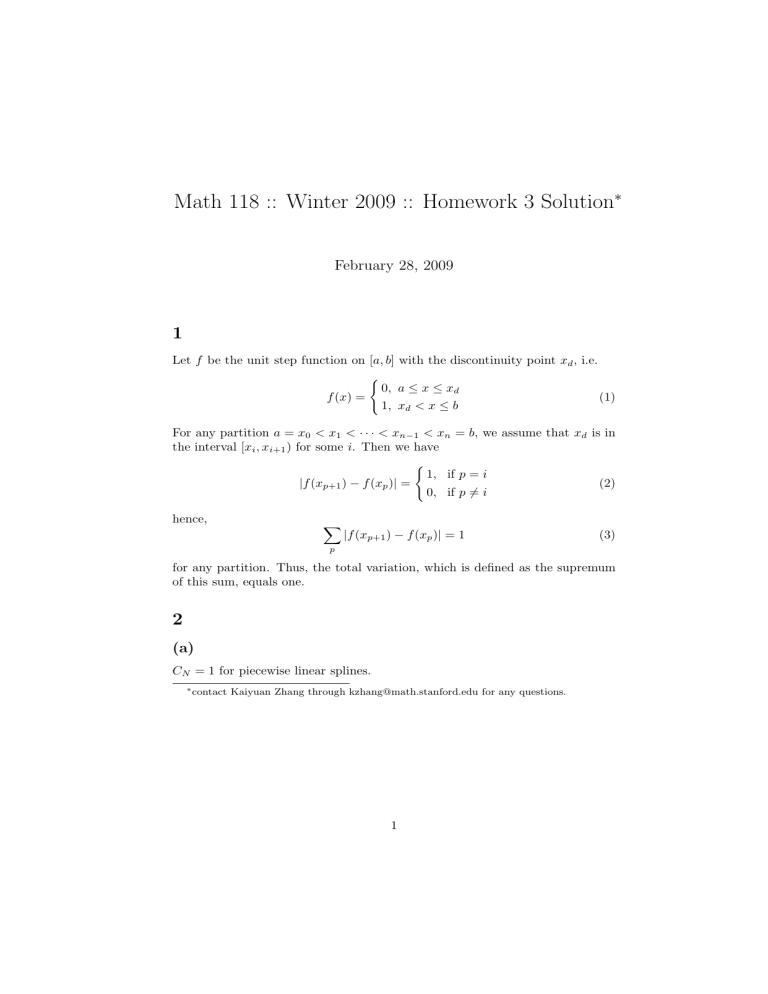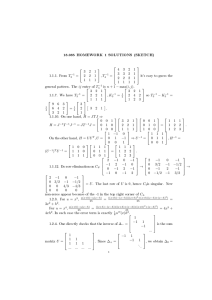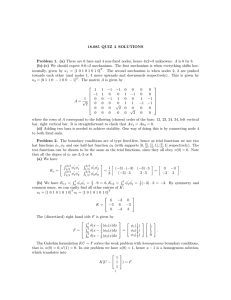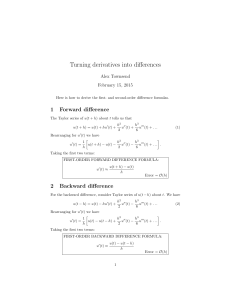Math 118 :: Winter 2009 :: Homework 3 Solution 1 ∗
advertisement

Math 118 :: Winter 2009 :: Homework 3 Solution∗ February 28, 2009 1 Let f be the unit step function on [a, b] with the discontinuity point xd , i.e. ( 0, a ≤ x ≤ xd f (x) = (1) 1, xd < x ≤ b For any partition a = x0 < x1 < · · · < xn−1 < xn = b, we assume that xd is in the interval [xi , xi+1 ) for some i. Then we have ( 1, if p = i |f (xp+1 ) − f (xp )| = (2) 0, if p 6= i hence, X |f (xp+1 ) − f (xp )| = 1 (3) p for any partition. Thus, the total variation, which is defined as the supremum of this sum, equals one. 2 (a) CN = 1 for piecewise linear splines. ∗ contact Kaiyuan Zhang through kzhang@math.stanford.edu for any questions. 1 (b) On the one hand, ¯ ¯ ¯X ¯ ¯N ¯ |p(x)| = ¯¯ yj k(x − xj )¯¯ ¯ j=1 ¯ ≤ N X (4) |yj ||k(x − xj )| (5) max |yi ||k(x − xj )| (6) j=1 ≤ N X j=1 i = max |yi | · i N X |k(x − xj )| (7) j=1 ≤ max |yi | · sup i x N X |k(x − xj )| (8) j=1 (9) One the other possible constant. Let x∗ PN hand, we show that CN is the smallest ∗ maximize j=1 |k(x − xj )| and yj be 1 if k(x − xj ) ≥ 0, −1 if k(x∗ − xj ) < 0. Then we have p(x∗ ) = N X yj k(x∗ − xj ) (10) |k(x∗ − xj )| (11) j=1 = N X j=1 Therefore, CN ≥ N N X X |p(x∗ )| = |k(x∗ − xj )| = sup |k(x − xj )| maxi |yi | j=1 x j=1 2 (12) (c) N X |Sh (x − xj )| (13) j=1 = ¯ N ¯ X ¯ sin((x − xj )π/h) ¯ ¯ ¯ ¯ (x − xj )π/h ¯ (14) ¯ N ¯ X ¯ sin(π(x − x0 )/h) ¯ ¯ ¯ ¯ π(x − x0 )/h − jπ ¯ (15) j=1 = j=1 =| sin(π(x − x0 )/h)| ¯ N ¯ X ¯ ¯ 1 ¯ ¯ ¯ π(x − x0 )/h − jπ ¯ (16) j=1 (17) Then, let y = π(x − x0 )/h, CN = sup x = sup y N X |Sh (x − xj )| N X | sin(y − jπ)| j=1 = sup | sin y| y (18) j=1 |y − jπ| N X j=1 1 |y − jπ| N 1 π X ≥ [let y = ] 2 j=1 (j − 12 )π| R 3π/2 1 R (N +1/2)π 1 dx dx π/2 x (N −1/2)π x ≥ + ··· + π π 1 = (ln((N + 1/2)π) − ln(π/2)) π 1 = ln(2N + 1) π 1 1 > ln N + ln 2 π π 3 (19) (20) (21) (22) (23) (24) (25) (d) We assume that N h < π/2. CN = sup x = sup x < sup x = sup x N X |SN (x − xj )| (26) | sin(π(x − xj )/h)| 2π/h| tan((x − xj )/2)| (27) j=1 N X j=1 N X | sin(π(x − xj )/h)| j=1 2π/h|(x − xj )/2| N X | sin(π(x − xj )/h)| j=1 |π(x − xj )/h| (28) (29) Therefore CN is smaller than that in (c). (e) Chebyshev interpolation is equivalent to a bandlimited interpolation on a periodic equispaced grid. Thus it has the same CN as (d). 3 dx Let H be the L2 space over [−1, 1] with the measure √1−x . For any f ∈ H, let 2 P∞ f = n=0 an Tn , then 1 ˆ hf, Tn i = fn (30) an = hTn , Tn i kTn k2 where fˆn = hf, Tn i (31) is the Fourier transform. Therefore the Plancherel Identity is kf k2H = ∞ X |an |2 kTn k2 = n=0 ∞ X 1 |fˆ |2 = kfˆk2G 2 n kT k n n=0 where G is the `2 space over n = 0, 1, 2, · · · and ( π, n = 0 kTn k2 = π/2, n > 0 4 (32) (33) 4 (a) y1 − y0 = −2 x1 − x0 y2 − y1 =4 z2 = −z1 + 2 x2 − x1 z1 = −z0 + 2 (34) (35) For k ≥ 2, yk does not change, so zk = 4 if k is even, zk = −4 if k is odd. (b) s0 (x) = 1 − x2 (36) 2 s1 (x) = −2(x − 1) + 3(x − 1) (37) 2 (38) 2 (39) s2 (x) = 1 + 4(x − 2) − 4(x − 2) s3 (x) = 1 − 4(x − 3) + 4(x − 3) 2 1.5 1 0.5 0 −0.5 0 0.5 1 1.5 2 2.5 3 3.5 (c) CN = 2 as we can see from the plot (and it is also easy to verify). 5 4 (d) http://en.wikipedia.org/wiki/Spline interpolation#Quadratic spline interpolation The coefficients z above are basically a running derivative approximation. Since only two points are used to calculate the next iteration’s curve (instead of three), this method is susceptible to severe oscillation effects when signal change is quickly followed by a steady signal. Without some sort of dampening, these oscillation effects make the above method a poor choice. 5 (a) 1 un+1 = un + (u0 )n h + (u00 )n h2 + 2 1 un−1 = un − (u0 )n h + (u00 )n h2 − 2 1 000 (u )n h3 + 6 1 000 (u )n h3 + 6 1 0000 (u )n h4 + o(h4 ) 24 1 0000 (u )n h4 + o(h4 ) 24 (40) (41) Then we have un+1 − 2un + un−1 1 = (u00 )n + (u0000 )n h2 + o(h2 ) h2 12 (42) It is a second order approximation. (b) Applying centered difference twice gives un+2 −un 2h n−2 − un −u un+2 − 2un + un−2 2h = 2h 4h2 (43) If we do some computation, 1 1 1 un+2 = un + (u0 )n (2h) + (u00 )n (2h)2 + (u000 )n (2h)3 + (u0000 )n (2h)4 + o(h4 ) 2 6 24 (44) 1 1 1 un−2 = un − (u0 )n (2h) + (u00 )n (2h)2 − (u000 )n (2h)3 + (u0000 )n (2h)4 + o(h4 ) 2 6 24 (45) Then we find that un+2 − 2un + un−2 1 = (u00 )n + (u0000 )n h2 + o(h2 ) 4h2 3 This has a larger error than the previous formula. 6 (46)










